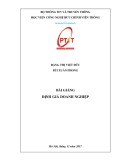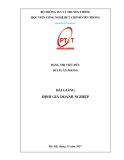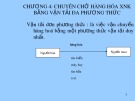
© Harry Campbell & Richard Brown
School of Economics
The University of Queensland
BENEFIT-COST ANALYSIS
BENEFIT-COST ANALYSIS
Financial and Economic
Financial and Economic
Appraisal using Spreadsheets
Appraisal using Spreadsheets
Ch. 12: Valuation of Non-marketed Goods

We have seen how in conducting efficiency benefit-cost
analysis we often use market prices, either directly or
indirectly, to value or cost project outputs or inputs.
We use market prices directly when they are generated by
perfectly competitive markets - markets that are not
distorted by monopoly, monopsony, taxes or regulations.
We use market prices indirectly when we adjust them to
generate shadow-prices. In this way prices that are
generated in imperfectly competitive markets can provide
information that can be used in the BCA.

For some project inputs or outputs there will be no market
in which they are traded, and hence no market price is
available for use either directly or indirectly in the BCA.
Some examples of non-marketed outputs or inputs:
- recreational fishing
- a nice view
- air or water pollution
- a life saved
- a disease prevented
Non marketed goods and services are just as relevant to
economic welfare as marketed commodities.

Since changes in the quantities of non-marketed goods and
services affect the level of economic welfare, they need to
be valued in efficiency and referent group BCA ( but not
in project or private BCA).
The analyst is very likely to encounter the problem of
valuing non-marketed commodities in BCA. Why?
Because project outputs or inputs do not have market prices
the market resource allocation may not be efficient. For
this reason governments see a need to regulate the private
market or undertake public expenditure in areas neglected
by the market.
The very fact that the government wants a BCA suggests
that there may be non-marketed commodities involved.

Why are some outputs or inputs that affect the level of
economic welfare not marketed?
The market is a vehicle for trade in commodities. For trade
to occur, property rights in the commodities have to be
reasonably complete and enforceable. Buyers may not be
willing to pay for an output or input unless they believe
they will have full and exclusive use of it for a specified
period of time, and will be able to sell it to someone else,
if they wish. Commodities that have these characteristics
are termed private goods.
Public goods are goods which lack some of the property
rights characteristics of private goods, and as a consequence
are not supplied in efficient levels by the private market.




















![Đề thi Tài chính cá nhân kết thúc học phần: Tổng hợp [Năm]](https://cdn.tailieu.vn/images/document/thumbnail/2025/20251015/dilysstran/135x160/64111760499392.jpg)


![Câu hỏi trắc nghiệm và bài tập Thị trường chứng khoán [mới nhất]](https://cdn.tailieu.vn/images/document/thumbnail/2025/20251001/kimphuong1001/135x160/75961759303872.jpg)


